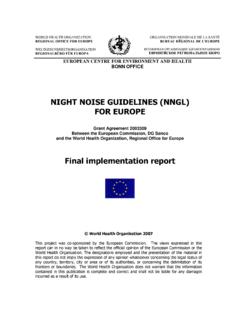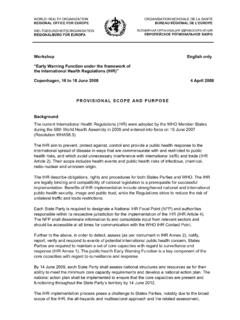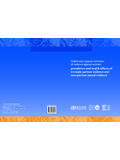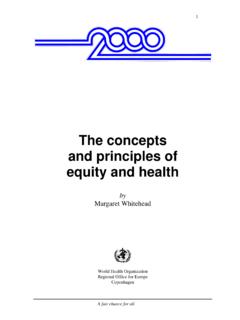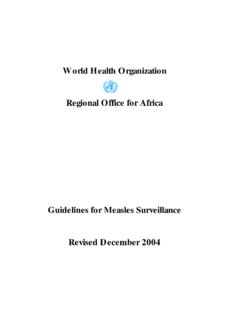Transcription of Sick building syndrome By: World Health Organization ...
1 Sick building syndrome By: World Health Organization regional Office for Europe Summary Sick building syndrome (SBS) describes a medical condition where people in a building suffer from symptoms of illness or feel unwell for no apparent reason. The symptoms tend to increase in severity with the time people spend in the building , and improve over time or even disappear when people are away from the building . Sick building syndrome results in substantial disruption of people's work performance and personal relationships, and considerable loss of productivity. Sick building syndrome is wide spread and may occur in offices, apartment houses, nurseries and schools, resulting in substantial costs to the community. Even though the cause effect relations are unclear it is possible to remedy buildings with SBS problems, and for new buildings the chances of avoiding SBS problems are also good.
2 Local Government actions can be both for implementing curative measures and for taking preventive actions. These measures and actions range from simple to radical. In recent years it has become apparent that occupants of buildings suffer a number of relatively minor illnesses where there is no apparent cause, yet it has been established that these are caused in some way by the building . The symptoms are varying degrees of irritation of the eyes, nose, throat or skin plus general symptoms such as lethargy and headaches. Because these illnesses may happen in the building or elsewhere, it was initially difficult to show that they could be caused by the building . While these symptoms may seem trivial at first sight, together they are a substantial problem. It was not until the medical condition of "Sick building syndrome " was identified that the actual size of the problem could be established and actions taken to improve the incidence of illness.
3 It now appears that Sick building syndrome (SBS) is wide-spread, with an estimated proportion as high as 30% of new, remodelled or renovated buildings having occupants with SBS. SBS may occur in most kinds of building : offices, apartment houses, nurseries and schools. It causes reduced work performance and increased absenteeism, resulting in a total cost which may well be in the range of of GNP. Even though the cause-effect relations are unclear, experience shows that it is possible to take measures to remedy established buildings with SBS problems. For new buildings, the chances of avoiding SBS problems are also good if sufficient attention is given at an early stage. A local authority can take actions which will make a big contribution to reducing the number of people with Sick building syndrome in its area. Sick building syndrome symptoms Modern people spend most of their time indoors in houses, day-care centres, schools, offices and other building facilities.
4 This means that if they are unwell, they will suffer symptoms and discomfort while indoors, only some of which may be related to the buildings they occupy. Sick building syndrome can be identified where people in a building experience, more frequently than expected, a range of common symptoms causing discomfort and a sense of being unwell. The most common symptoms are the following: irritated, dry or watering eyes (sometimes described as itching, tiredness, redness, burning or difficulty wearing contact lenses), irritated, runny or blocked nose (sometimes described as congestion, nosebleeds, itchy or stuffy nose), dry or sore throat (sometimes described as irritation, upper airway irritation or difficulty swallowing), dryness, itching or irritation of the skin, occasionally with a rash, less specific symptoms such as headache, lethargy, irritability and poor concentration.
5 Typically several of these symptoms are experienced simultaneously and they are often accompanied by complaints about stuffiness, poor air, dry air, noise, light or temperatures which are too hot or too cold. For some illnesses clear-cut connections to the building have been recognized. These are not included in SBS: infections such as colds and those that emanate from sanitary equipment, chronic illness caused by tobacco smoke poisoning from building materials such as lead in paint, legionellosis, effects of pollutants from industrial processes, cancer from radon asbestos-related diseases, general effects of dampness, thermal comfort effects hearing loss from noise. In other situations, however, they are Health problems which seem to be building -related, but where there is no apparent cause requiring attention. The recent identification of the Sick building syndrome as a medical condition has provided the focus to allow local government to deal with the problem.
6 A building where there are a substantial number of people with SBS symptoms is referred to as a "sick building ". Sick building syndrome in Europe The common feature of sick buildings is that their occupants suffer, or appear tu suffer, a measurably higher incidence of symptoms of illness or discomfort than can reasonably be expected. A sick building may result from the way in which the building is designed and constructed or from the way it is operated, maintained and used. Since the causes of SBS have not been identified, the best way of finding out if there is a problem is to look at the frequency of complaints or symptoms of illness. SBS reports from various European countries show that this is a widespread problem. According to a WHO expert group in the mid-1980s. up to 30% of new or remodelled buildings may have unusually high rates of complaints. This conclusion has been supported by many other studies.
7 The recognition of SBS as an illness varies from country to country and the characteristics that are included in reports also vary considerably between countries. However, it is apparent that the sumptoms occur in various kinds of building : offices, apartment houses, nurseries and schools. For example, a recent enquiry among 10,000 people living in Stockholm, Sweden, revelated that 13% of those living in apartment buildings complain about Health problems which they relate to the indoor environment. Other Swedish studies indicate still more frequent malfunctions, for example complaints in some 25% of all kindergartens in Stockholm and 20% of all kindergartens in Stockholm and 20% of all municipal buildings in the city of Malm . A major survey of the indoor climate in more than 3000 Swedish homes, in both single units and buildings containing multiple dwellings, has recently been carried out.
8 The report from this project reveals that one in ten residents in buildings containing multiple residences complains about stuffy air, dry air, noise, dust and dirt. The situation appears to be considerably better in single family homes that were constructed after 1975. In this study the most frequent symptom was tiredness. In every third or fourth case the sumptoms are presumed to be related to the residential indoor climate. Health implications SBS is a problem which can be removed or prevented. It is an unnecessary cause of ill- Health with considerable loss of productivity and quality of life for those affected. For people affected by SBS the symptoms can cause substantial disruption to both their work performance and personal relationships. This will have a major impact on productivity in the work place, which is shown in reduced performance, increased absenteeism, reduced overtime, increased staff turnover and demands on management and trade unions trying to resolve the problem.
9 British estimates from various studies indicate that up to 8% of the working population regularly experience SBS symptoms tu such an extent that their Health and productivity are seriously affected. It is important to remember, however, that the symptoms of SBS can be regarded as minor, since recovery is usually quite rapid as soon as the problem is identified and remedial measures taken. When sick building problems occur in kindergartens, schools and hospital where the individuals are more sensitive and spend a large amount of time, the situation should be regarded as of great concern. Economic aspects The total cost of SBS on a country's economy has not been comprehensively studied, although estimates indicate it is likely to be substantial. Extreme cases of buildings being closed or demolished are rare. The most obvious costs of SBS are due to increased absenteeism and increased staff turn-over.
10 Economic costs, which are very difficult to assess, are those due to reduced work performance, the use of management time to deal with complaints, and time and costs involved in trying to establish and eliminate the problems. In a British study of a particularly troublesome large office building , the loss of productivity is subjectively estimated to range from 3% for staff taking "sick leave" up to 33% for staff who are "sometimes less productive". An American study estimated that the total cost of SBS may range from US$5 billion up to several tens of billions for the USA. If the costs for Health care, social security and building works are added, the total may be of GNP. A moderate assumption from these figures is that 1 day per person per year is lost through sick leave, productivity loss, extended breaks, etc. Another 1 hour per month is required for dealing with problems.
